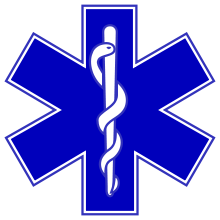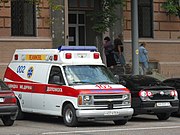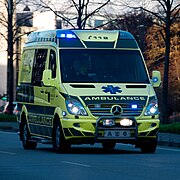
The Star of Life is a symbol used to identify emergency medical services. It features a blue six-pointed star, outlined by a white border. The middle contains a Rod of Asclepius – an ancient symbol of medicine. The Star of Life can be found on ambulances, medical personnel uniforms, and other objects associated with emergency medicine or first aid. Elevators marked with the symbol indicate the lift is large enough to hold a stretcher. Medical bracelets sometimes use the symbol to indicate one has a medical condition that emergency services should be aware of.
The Star of Life is widely used around the world, but like many international symbols, it has not been adopted everywhere. Its use is restricted to authorized personnel in some countries.
History

The Star of Life originated in the United States. In 1963, the American Medical Association (AMA) designed the Star of Life as a "universal" symbol for medical identification. The AMA did not trademark or copyright the symbol, stating it was being "freely offered" to manufacturers, and also was for use on cards carried by persons with a medical condition.
By way of a 1964 resolution, it was adopted by the World Medical Association "as the universal emergency medical information symbol." The Star of Life was promoted by the American Red Cross and rapidly adopted worldwide.
In 1970, when the American Medical Association's Committee on Emergency Medical Services formed the National Registry of Emergency Medical Technicians (NREMT), the AMA chose the Star of Life to designate nationally certified Emergency Medical Services personnel. In 1973, the NREMT filed for a trademark for the Star of Life logo, under the category of a collective membership mark. This version featured a Star of Life enveloped by a circle. NREMT's trademark was granted in 1975, but "was not renewed and therefore has expired." NREMT subsequently registered a service mark featuring a Star of Life and the words "NATIONAL REGISTRY." This logo's trademark remains active.
Prior to the use of the Star of Life, ambulances in the United States commonly displayed a safety orange-colored cross on a square background. This was only a slight variation from the inverted Swiss flag (✚) used by the International Red Cross and Red Crescent Movement. In 1973, the American Red Cross complained that the traditional orange cross too closely resembled their logo of a red cross on a white background, the usage of which is restricted by the Geneva Conventions. Dr. Dawson Mills, Chief of the EMS Branch, National Highway Traffic Safety Administration in the United States, asked the National Registry of EMTs for permission to use the star as the "national identifier for Emergency Medical Services" in the United States," and in 1977 reported to Congress that it had become the national standard.
Leo R. Schwartz, Chief of the EMS Branch, National Highway Traffic Safety Administration in the United States, modified the Star of Life by adding the six main tasks of Emergency Medical Services and changing the color from red (used by the AMA) to blue. The "blue Star of Life" was recommended for adoption by the United States Department of Health, Education and Welfare on October 25, 1973, and was registered as a certification mark on February 1, 1977 in the name of the National Highway Traffic Safety Administration. Both NREMT's version and the US government's modification omit the white outline around the edge common on many of today's ambulances.
The US government's registration lists uses of the Star of Life, including "emergency medical care" and "emergency medical care vehicles." The US government's registration does not list any international classes of trademark.
Federal standards dictate requirements ambulances in the US must satisfy in order to display the Star of Life. The federal government has given states additional authority to manage the symbol. Private ambulance operators like AMR have trademarked logos featuring an embedded Star of Life.
Symbolism

The six branches of the star represent the six main tasks executed by rescuers all through the emergency chain:
- Detection: The first rescuers on the scene, usually untrained civilians or those involved in the incident, observe the scene, understand the problem, identify the dangers to themselves and the others, and take appropriate measures to ensure their safety on the scene (environmental, electricity, chemicals, radiation, etc.).
- Reporting: The call for professional help is made and dispatch is connected with the victims, providing emergency medical dispatch.
- Response: The first rescuers provide first aid and immediate care to the extent of their capabilities.
- On scene care: The EMS personnel arrive and provide immediate care to the extent of their capabilities on-scene.
- Care in transit: The EMS personnel proceed to transfer the patient to a hospital via an ambulance or helicopter for specialized care. They provide medical care during the transportation.
- Transfer to definitive care: Appropriate specialized care is provided at the hospital.
Global usage
Asia
Ambulances in Taiwan, mainland China, Hong Kong, and Macau display the Star of Life. The symbol is also widely used in Japan, Malaysia, the Philippines, and Singapore. It is less common in South Korea, where ambulances display a green cross and green lights.
West Asia

Most ambulances in Turkey do not use the Star of Life. Ambulances in Iran commonly display the Star of Life. Egyptian Ministry of Health ambulances display the Star of Life on one rear door, and a red crescent on the other. National Ambulances in the United Arab Emirates does not display the Star of Life, instead showing an EKG graphic on the sides and rear. In Saudi Arabia, the Red Crescent Society answers the emergency line, and provides service in vehicles bearing the crescent emblem.
In Israel, Magen David Adom displays a red Jewish star, sometimes shown with a Star of Life. The Jewish star is paired with the red crystal in times of conflict. Israel's other ambulance operator, United Hatzalah, has a logo based on both stars. "The Star of Life is a universal symbol of emergency medical care. The Star of David is our national symbol. Combining these two elements reminds us of the messages that we...focus on." said United Hatzalah's president.
In Palestine, the Palestine Red Crescent Society provides ambulance service in vehicles displaying a red crescent, alongside private operators who often display the Star of Life.
India
Indian Automotive Industry Standard AIS-125 is the National Ambulance Code of India. This document is managed jointly by the Automotive Research Association and the Ministry of Road Transport and Highways. It requires ambulances display several distinctive markings including a reflective Battenburg pattern, the word "AMBULANCE", and the emergency telephone number. The standard states "Displayed on the upper half of the left side should be a 'Star of Life' symbol, with a size of 40cm x 40cm... Displayed on the left back window should be a 'Star of Life' symbol, with a size of 85% of the window".
Central and South America
The Star of Life is used in many Spanish speaking nations, where it is known as La Estrella De La Vida. In Argentina, the Sistema de Atención Médica de Emergencia [es] (SAME), the capital district ambulance service, uses a green and slightly rounded version of the Star of Life in their logo. In Brazil, the Star of Life is known by its Portuguese name Estrela da Vida. A red Star of Life is incorporated into the national emergency service's visual identity standards. Brazil's ABNT Standard NBR 14561 for ambulance design makes direct reference to being based on the American Star of Life vehicle. Ambulances which do not comply with the Brazilian standard are prohibited from displaying the Star of Life or the word “RESGATE” (rescue).
Australia and New Zealand

A few patient transport providers like Ambulance Service Australia use the Star of Life. However, it is far more common to see the Maltese Cross in this region.
Europe
The European Union's ambulance design standard CEN 1789 in section A1 Recognition and Visibility of Ambulances states:
With the exception of Red Cross societies or where the "Star of life" is locally registered, a blue reflective "Star of life" emblem (minimum size 500 mm) together with reflective letters, numerals or a symbol identifying the organization and the vehicle, should be applied to the roof of the ambulance...a blue reflective "Star of life" emblem should be applied to the sides and rear of the ambulance.
In Portugal, the Star of Life is referred to by the Portuguese name Estrela da Vida. In March 1977, the then National Ambulance Service of Portugal (the present INEM, National Medical Emergency Institute) filed a trademark registration on the symbol, which was granted in 1981. The INEM continues to hold a trademark registration in the country, which is used to certify that vehicles are "in accordance with INEM standards" and personnel have "proper preparation". It may also be used on maps and road signs "to indicate the location or access to qualified emergency medical care services".
Belgian EMTs use blue stars; nurses, doctors, and ambulance drivers wear other colors. In the Netherlands, the Star of Life is widely used. The Dutch government owns a trademark on the symbol, alongside the paint scheme used on emergency vehicles.
After Latvia became independent in 1918, ambulance services in the 1920s and 1930s were provided by the Latvian Red Cross and thus displayed the Red Cross symbol. During the Soviet control of Latvia, that symbol continued to be used as a general symbol of medicine. As restoration of independence, the Riga Emergency Medical Service Station called on the government to adopt the Star of Life (Latvian: Dzīvības zvaigzne, sometimes sniegpārsla - 'snowflake') and the change was made with effect from 12 January 1995. It is currently used on vehicles, uniforms and medical service buildings.
In Germany, the symbol was registered in 1993 by industry association BKS, an umbrella organization for private rescue services there. In December 2020, another ambulance industry association, DBRD, filed a challenge with the German Patent and Trade Mark Office. The challengers hired a law firm specializing in intellectual property rights to research the symbol's history. This led to allegations the Star of Life had already been in widespread public use since the 1960s, before being registered in Germany (or the US for that matter). The challengers claimed the trademark office seemed to have been not properly informed of these facts, which presumably could have led the original application to have been denied on public domain grounds. The European Union Intellectual Property Office's 2014 rejection of a trademark on a minimally modified Star of Life was also cited. As of August 2022, BKS continues to hold German copyright on the symbol.

In the United Kingdom, some NHS ambulances in the UK display the Star of Life in addition to the local Ambulance Service emblem. These (latter) emblems have a pale gold six-spoked wheel with a Rod of Asclepius in the foreground. A crown and Maltese Cross, a common EMS emblem in Commonwealth nations, are included in the design.
Gallery
The symbol in use-
 An ambulance in Kyiv, Ukraine
An ambulance in Kyiv, Ukraine
-
 New Taipei City Fire Department ambulance in Taiwan
New Taipei City Fire Department ambulance in Taiwan
-
 Fire department ambulance in Fairfax County, Virginia, US
Fire department ambulance in Fairfax County, Virginia, US
-
 An ambulance in Denmark
An ambulance in Denmark
Unicode
| ⚕ | |
|---|---|
| Staff of Aesculapius | |
| In Unicode | U+2695 ⚕ STAFF OF AESCULAPIUS |
| Related | |
| See also | U+2731 ✱ HEAVY ASTERISK U+1F7BA 🞺 EXTREMELY HEAVY SIX SPOKED ASTERISK |
The snake-and-staff element of the symbol has a Unicode code point called the Staff of Aesculapius. Unicode has no dedicated code point for the Star of Life.
See also
- First aid
- Emergency medical technician
- Emblems of the International Red Cross and Red Crescent Movement
References
- (Editorial) (1964). "[American Heart] Association Acts to Promote Medical Identification Symbol". Circulation. 30 (1): 7. doi:10.1161/01.CIR.30.1.7.
- "Universal Medical Identification Symbol". Am J Dis Child. 107 (5): 439. 1964. doi:10.1001/archpedi.1964.02080060441001.
- Nielen, Michael (4 December 2020). "Maucher Jenkins files an invalidation action for DBRD against the BKS "Star of Life" trademarks at the German PTO". Maucher Jenkins (Press release). Retrieved 2 January 2022. (Note that Maucher Jenkins is representing one party in the trademark dispute.)
- Dukelow, Donald (1966). "Emergency Medical Identification Symbol". School Health. 36 (1): 20–21. doi:10.1111/j.1746-1561.1966.tb05512.x. PMID 5174672.
- "Developing Emergency Medical Services" (PDF). American Medical Association. Retrieved 17 February 2020.
- "History of the National Registry of EMTs". National Registry of EMTs. Retrieved 17 February 2020.
- "USPTO Trademark Search of US Serial #72454410". U.S. Patent and Trademark Office. September 9, 1975. Retrieved 17 February 2020.
- "USPTO Trademark Search of US Serial #78453390". U.S. Patent and Trademark Office. Retrieved 17 February 2020.
- "Star of Life - The EMS Symbol". South Dakota EMS. Archived from the original on 2007-07-11. Retrieved 2007-06-29.
- Prehospital Care Pearls and Pitfalls. People's Medical Publishing House. 2012. ISBN 9781607951711. Retrieved 17 February 2020.
- Department of Transportation and Related Agencies Appropriations for 1977 Hearings Before a Subcommittee of the Committee on Appropriations, House of Representatives, Ninety-fourth Congress, Second Session. Page 224. United States Congress. 1976.
- "Star of Life' - Northern Virginia EMS Council
- Star of Life Emergency Medical Care Symbol (Report). DOT HS 803 721. United States Department of Transportation, NHTSA. January 1979.
- "USPTO Trademark Search of US Serial #1058022". U.S. Patent and Trademark Office. February 1, 1977. Retrieved 17 July 2019.
- "USPTO Trademark Search of US Serial #73033491". U.S. Patent and Trademark Office. February 1, 1977. Retrieved 17 July 2019.
- "Federal Specification for the Star-of-Life Ambulance" (PDF). U.S. General Services Administration. US General Services Administration. August 1, 2007. p. 3.
- ""Star of Life"" (PDF). US Department of Transportation National Highway Traffic Safety Administration. June 1995. Archived from the original (PDF) on 2017-11-07. Retrieved 2021-12-29.
- "Trademark Status & Document Retrieval US Serial #75134611". US Patent and Trademark Office. July 15, 1996. Retrieved 2021-12-29.
- "Star of Life". Retrieved 2007-06-29.
- "300 new ambulances for Egypt. - Wietmarscher Ambulanz- und Sonderfahrzeug GmbH". www.was-vehicles.com. Retrieved 2021-12-30.
- "Constructional and Functional Requirements for Road Ambulances (National Ambulance Code)" (PDF). The Automotive Research Association of India, on behalf of Automotive Industry Standards Committee, under Central Motor Vehicle Rules – Technical Standing Committee set-up by Ministry of Road Transport and Highways (Department of Road Transport and Highways), Government of India. June 2013.
- "Historia de la Estrella de La Vida" (PDF). Revista del Hospital J. M. Ramos Mejía.
- "SAMU 192 Manual De Identidade Visual" (PDF). Sistema Único de Saúde. Retrieved Dec 29, 2021.
- Veículos para atendimento a emergências médicas e resgate. NBR 14561. Projeto 24:302.07-002:1999. Rio de Janeiro: ABNT – Associação Brasileira de Normas Técnicas. 2000. p. 1.
- "Final Draft prEN 1789 "Medical vehicles and their equipment - Road ambulances"" (PDF). CEN/TC 239. Archived from the original (PDF) on 24 October 2014. Retrieved 2021-12-29.
- "The Star of Life - SYMBOL OF INEM". Instituto Nacional de Emergência Médica. 2017.
- "Dringende geneeskundige hulpverlening: verhoogde herkenbaarheid van voertuigen en personeel voor meer veiligheid" [Urgent medical assistance: increased recognizability of vehicles and personnel for more safety]. Presscenter.org. 2018-01-11. Archived from the original on 2018-01-11. Retrieved 2022-01-02.
- "Striping & Star of Life: beschermde beeldmerken" [Striping & Star of Life: protected logos]. www.ambulancezorg.nl (in Dutch). Retrieved 2022-01-02.
- "Dzīvības zvaigzne: ātrai palīdzībai – 100" [Star of Life: emergency medical service - 100]. Apollo.lv. 2004-03-02.
- ^ "Registerauskunft | Registernummer: 2032229 (Marke eingetragen , Stand am: 08.08.2022)". Deutsches Patent und Markenamt. 12 March 1993. Retrieved 8 August 2022.
- "DBRD geht gegen "Star of Life"-Regelung vor" [DBRD takes action against "Star of Life" registration]. www.rettungsdienst.de. Retrieved 2022-01-02.
External links
- Wikibooks:First Aid
- Star of Life from EMS Archived 2009-06-07 at the Wayback Machine
- The San Diego Paramedics: Caduceus